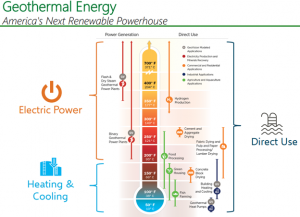END USES
- Geothermal technologies use heat from the earth, either directly for such applications as heating and cooling, or as a source of renewable electricity. Some applications of geothermal energy use the earth's temperatures near the surface. Other applications require drilling miles into the earth.
Three key geothermal applications include:
- Direct Use and District Heating systems - uses hot water from springs or reservoirs near the earth’s surface where the geothermal heat is used directly for heating spaces, bathing, and cooking. Geothermal energy is also used for district heating systems to directly heat individual or multiple buildings using the hot water near the surface, which is piped into buildings for heat. Shallower reservoirs of lower temperatures between 70-300°F are used directly in health spas, greenhouses, fish farms, industry and in residential and commercial space heating systems.[1]
- Geothermal electricity - is generated by geothermal power plants and requires water or steam at very high temperatures (i.e., at 300ºF to 700ºF). If geothermal reservoirs are close enough to the surface, they can be tapped by drilling wells, sometimes over two miles deep. Wells are drilled into geothermal reservoirs to access the hot water needed to generate geothermal electricity. Hot water and steam shoot up the wells naturally, or are pumped to the surface, where they are used to generate electricity in geothermal power plants. Geothermal power plants are typically constructed within a mile or two of the earth’s surface where geothermal reservoirs are located. The U.S. leads the world in the amount of geothermal electricity generated.
- Geothermal Heat Pumps (GHPs) - use the consistent ground or water temperatures near the earth’s surface to control above ground building temperatures (i.e., to heat or cool). To provide heating, GHPs transfer heat from the ground (or water) into buildings. For cooling, the process is reversed, and GHPs instead transfer heat from the building into the ground.[2]
The wide variety of geothermal resources allows them to be used on both large and small scales. Sample uses include:
- Industrial applications include using geothermal energy for food dehydration (drying), milk pasteurizing, and gold mining.
- Aquaculture applications include using geothermal water for fish farming.
- Agricultural applications include using geothermal heat for greenhouse heating.
- In the food industry, geothermal hot water and steam can be used in evaporation and distillation processes, and sterilization processes.[3]

Source: DOE[4]
Updated June 2022 by Diane M. Long

Comments are closed.